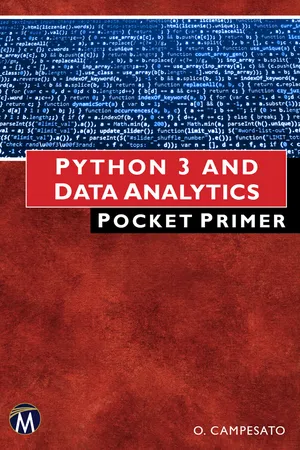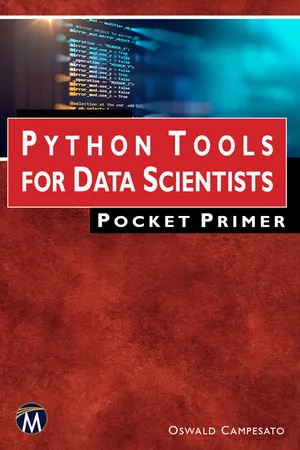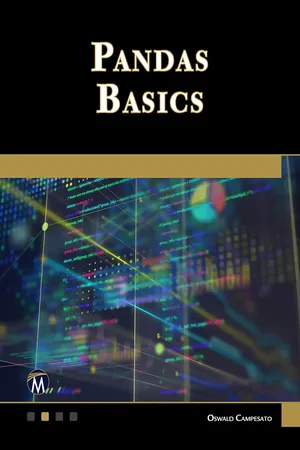Computer Science
Scatter Chart Python
A scatter chart in Python is a type of data visualization that displays individual data points on a two-dimensional graph. It is commonly used to show the relationship between two variables and identify patterns or trends in the data. In Python, scatter charts can be created using libraries such as Matplotlib or Seaborn, providing flexibility in customization and presentation.
Written by Perlego with AI-assistance
Related key terms
Related key terms
1 of 4
Related key terms
1 of 3
4 Key excerpts on "Scatter Chart Python"
- eBook - ePub
- Oswald Campesato(Author)
- 2021(Publication Date)
- Mercury Learning and Information(Publisher)
Matplotlib , which is an open-source Python library that is modeled after MATLAB. This section also provides the Python code samples for the line graphs (horizontal, vertical, and diagonal) in the Euclidean plane that you saw in a previous chapter.The third part of the chapter introduces you to Sklearn , which is a very powerful Python library that supports many machine learning algorithms and also supports visualization. If you are new to machine learning, fear not: this section does not require a background in machine learning in order to understand the Python code samples.The fourth part of the chapter introduces you to Seaborn for data visualization, which is a layer above Matplotlib . Although Seaborn does not have all of the features that are available in Matplotlib , Seaborn provides an easier set of APIs for rendering charts and graphs.The final portion of this chapter contains a very short introduction to Bokeh , along with a code sample that illustrates how to create a more artistic graphics effect with relative ease in Bokeh .WHAT IS DATA VISUALIZATION?Data visualization refers to presenting data in a graphical manner, such as bar charts, line graphs, heat maps, and many other specialized representations. As you probably know, Big Data comprises massive amounts of data, which leverages data visualization tools to assist in making better decisions.A key role for good data visualization is to tell a meaningful story, which in turn focuses on useful information that resides in datasets that can contain many data points (i.e., billions of rows of data). Another aspect of data visualization is its effectiveness: how well does it convey the trends that might exist in the dataset? - eBook - ePub
- Oswald Campesato(Author)
- 2022(Publication Date)
- Mercury Learning and Information(Publisher)
6DATA VISUALIZATIONWhat is Data Visualization?T his chapter introduces data visualization, along with a wide-ranging collection of Python-based code samples that use various visualization tools (including Matplotlib and Seaborn) to render charts and graphs. In addition, this chapter contains Python code samples that combine Pandas, Matplotlib, and built-in datasets.The first part of this chapter briefly discusses data visualization, with a short list of some data visualization tools, and a list of various types of visualization (such as bar graphs and pie charts).The second part of this chapter introduces you to Matplotlib, which is an open source Python library modeled after MatLab. This section also provides the Python code samples for the line graphs (horizontal, vertical, and diagonal) in the Euclidean plane that you saw in a previous chapter.The third part of the chapter introduces you to Seaborn for data visualization, which is a layer above Matplotlib. Although Seaborn does not have all of the features that are available in Matplotlib, Seaborn provides an easier set of APIs for rendering charts and graphs.The final portion of this chapter contains a very short introduction to Bokeh, along with a code sample that illustrates how to create a more artistic graphics effect with relative ease in Bokeh.Data visualization refers to presenting data in a graphical manner, such as bar charts, line graphs, heat maps, and many other specialized representations. As you probably know, big data comprises massive amounts of data, which leverages data visualization tools to assist in making better decisions.A key role for good data visualization is to tell a meaningful story, which in turn focuses on useful information that resides in datasets that can contain many data points (i.e., billions of rows of data). Another aspect of data visualization is its effectiveness: how well does it convey the trends that might exist in the dataset? - Yasha Hasija, Rajkumar Chakraborty(Authors)
- 2021(Publication Date)
- CRC Press(Publisher)
5Python for Data VisualizationIntroduction
“Data science” is a buzzword in today’s age of high throughput biology. When we say data science, we handle enormous amounts of data and arrive at insights into biological findings. Up until this point, we have learned how to handle large datasets and how to do an efficient calculation on these. Data visualization is another way to derive insights from data through visualizations by using elements like graphs (e.g. scatterplots, histograms, etc), maps, or charts that allow for the understanding of complexities within the data by identifying local trends or patterns, forming clusters, locating outliers, and more. Data visualization is the preliminary step after loading the data to view the distribution of values. Cleaning the data, checking the quality of data, doing exploratory data analysis, and presenting data and results are some of the necessary tasks that a data scientist needs to do before applying any Machine Learning or statistical model on the data. In this chapter, we will describe one of the primary data visualization libraries of Python called “Matplotlib” and draw a few basic graphics. Next, we will browse through a library called “Seaborn” which provides a high-level interface for drawing beautiful and informative statistical graphs. Lastly, we will learn about interactive and geographical data plotting.Matplotlib
Matplotlib is the most popular plotting library in the Python community. It gives us control over almost every aspect of a figure or plot. Its design is familiar with Matlab, which is another programming language with its own graphical plotting capabilities. The primary goal of this section is to go through the basics of plotting using Matplotlib. If we have Anaconda distribution, then we have acquired Matplotlib installed by default, or else we have to install it using a “pip” installer. Matplotlib is imported as “plt”, similar to “np” for NumPy and “pd” for pandas. To view the graphs in the Jupyter Notebook, we have to use a Jupyter function “%matplotlib inline” in the notebook. The notebook of this chapter can be found with the supplementary files labeled as “Python for Data Visualization5.ipnyb”.- eBook - ePub
- Oswald Campesato(Author)
- 2022(Publication Date)
- Mercury Learning and Information(Publisher)
7DATA VISUALIZATIONT his chapter introduces data visualization, along with a wide-ranging collection of Python-based code samples that use various visualization tools (including Matplotlib and Seaborn) to render charts and graphs. In addition, this chapter contains Python code samples that combine Pandas, Matplotlib, and built-in datasets.The first part of this chapter briefly discusses data visualization, with a short list of some data visualization tools, and a list of various types of visualization (bar graphs, pie charts, and so forth).The second part of this chapter introduces you to Matplotlib, which is an open source Python library that is modeled after MatLab. This section also provides the Python code samples for the line graphs (horizontal, vertical, and diagonal) in the Euclidean plane that you saw in a previous chapter.The third part of the chapter introduces you to Seaborn for data visualization, which is a layer above Matplotlib. Although Seaborn does not have all of the features that are available in Matplotlib, Seaborn provides an easier set of APIs for rendering charts and graphs.The final portion of this chapter contains a very short introduction to Bokeh, along with a code sample that illustrates how to create a more artistic graphics effect with relative ease in Bokeh.WHAT IS DATA VISUALIZATION?
Data visualization refers to presenting data in a graphical manner, such as bar charts, line graphs, heat maps, and many other specialized representations. As you probably know, Big Data comprises massive amounts of data, which leverages data visualization tools to assist in making better decisions.A key role for good data visualization is to tell a meaningful story, which in turn focuses on useful information that resides in datasets that can contain many data points (i.e., billions of rows of data). Another aspect of data visualization is its effectiveness: how well does it convey the trends that might exist in the dataset?
Index pages curate the most relevant extracts from our library of academic textbooks. They’ve been created using an in-house natural language model (NLM), each adding context and meaning to key research topics.
Explore more topic indexes
Explore more topic indexes
1 of 6
Explore more topic indexes
1 of 4



